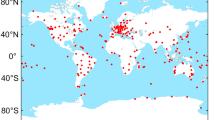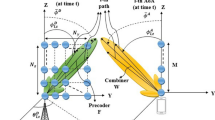Abstract
In this paper we present an original subspace-based method for direction finding by an array of uncalibrated isotropic sensors. This iterative method has been developed in order to estimate both direction-of-arrival of non circular signal sources and the unknown gain and phase of sensors. The non circular sources assumption, leads to an extended array data model which doubles the dimension of the observation space from the classical data model. One of the benefits of this approach is that the proposed procedure works even in the case where the number of sources is greater than the number of sensors. Some computer simulation results are provided is order to illustrate the performance of our algorithm, and to show the advantages of exploiting the non circularity of signal sources.
Résumé
Cet article présente un algorithme d’autocalibrage d’une antenne multicapteur. Cet algorithme permet d’estimer le gain et la phase des capteurs, dont la connaissance précise est nécessaire pour localiser les sources en présence. L’originalité de notre approche réside dans la prise en compte de la non-circularité des sources pour calibrer une antenne. L’exploitation de cette caractéristique permet d’augmenter la dimension de l’espace des observations, et de localiser des sources en nombre supérieur à celui des capteurs. Des simulations ont été effectuées afin de montrer la performance de cet algorithme.
Similar content being viewed by others
References
Schmu (R.O.), Multiple emitter location and signal parameters estimation,IEEE Transactions on Antennas and Propagation,34, pp. 276–280, March 1986.
Friedlander (B.), A sensitivity analysis of theMusic algorithm,IEEE Transactions on Acoustic, Speech, Signal Processing,38, pp. 1740–1751, October 1990.
Swindlehurst (A.L.) andKaïlath (T.), A performance analysis of subspace-based methods, in the presence of model errors - Part 1: The music algorithm,IEEE Transactions on Signal Processing, July 1992,40, pp. 1758–1774.
Paulraj (A.), Kaïlath (T.), Direction of arrival estimation by eigenstructure methods with unknown sensor gain and phase,Proceedings IEEE International Conference on Acoustic, Speech, Signal Processing, pp. 640–643, 1985.
Friedlander (B.), A. Weiss (A.), Eigenstructure methods for direction finding with sensor gain and phase uncertainties,Proceedings IEEE International Conference on Acoustic, Speech, Signal Processing, pp. 2681-2684, 1988.
Brown (G.C.), McClellan (J.H.), Holder (E.J.), Eigenstructure approach for array processing and calibration with general phase and gain perturbations,Proceedings IEEE International Conference on Acoustic,Speech, Signal Processing, pp. 1365-1368, 1991.
Zhang (M.), Zhu (Z.), A method for direction finding under sensor gain and phase uncertainties,ieee Transactions on Antennas and Propagation,43, pp. 880–883, August 1995.
Astély (D.), Swindlehurst (L.), Ottersten. (B.), Spatial signature estimation for uniform linear anays with unknown receiver gains and phases,IEEE Transactions on Signal Processing,47, pp. 2128–2138, August 1999.
Fuhrmann (D.), Estimation of sensor gain and phase,ieee Transactions on Signal Processing,42, n° 1, pp. 77–87, January 1994.
Ng (A.), Direction-of-anival estimates in the presence of wavelength, gain, and phase errors,ieee Transactions on Signal Processing,43, n° 1, pp. 225–232, January 1995.
Yip (P.), Zhou (Z.), A self-calibration algorithm for cyclostationnary signals and its uniqueness analysis, Proceedings ieee International Conférence on Acoustic, Speech, Signal Processing, pp. 1892–1895, 1995.
Picinbono (B.), On circularity,IEEE Transactions on Signal Processing,42, pp. 3473–3482, December 1994.
Lacoume (J.L.), Complex random variables and signals,Traitement du Signal,15, n° 6, pp. 535–544, 1998.
Galy (J.), Antenne adaptative: du second ordre aux ordres supérieurs, applications aux signaux de télécommunications,Ph.D. Dissertation, Paul Sabatier University, Toulouse, 1998.
Brandwood (D.H.), A complex gradient operator and its application in adaptative array theory,IEEE Proc.,130, pp. 11–16, February 1983.
Author information
Authors and Affiliations
Corresponding authors
Rights and permissions
About this article
Cite this article
Chargé, P., Wang, Y. & Saillard, J. Joint array calibration and direction-of-arrival estimation for non circular sources. Ann. Télécommun. 57, 7–21 (2002). https://doi.org/10.1007/BF02994608
Received:
Accepted:
Issue Date:
DOI: https://doi.org/10.1007/BF02994608
Key words
- Antenna array
- Goniometry
- Multiple source
- N-dimension signal
- Random signal
- Statistical estimation
- Parameter estimation




